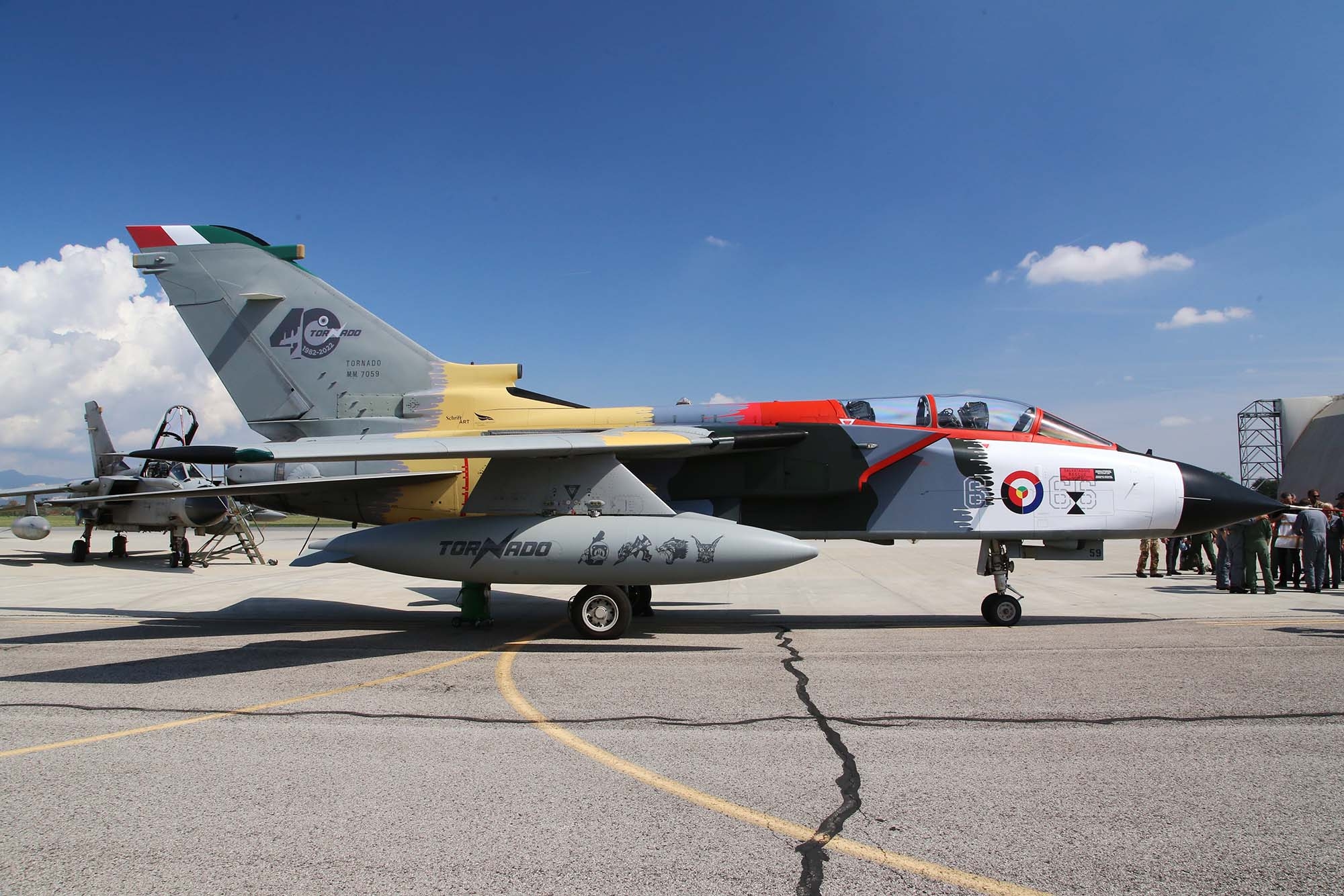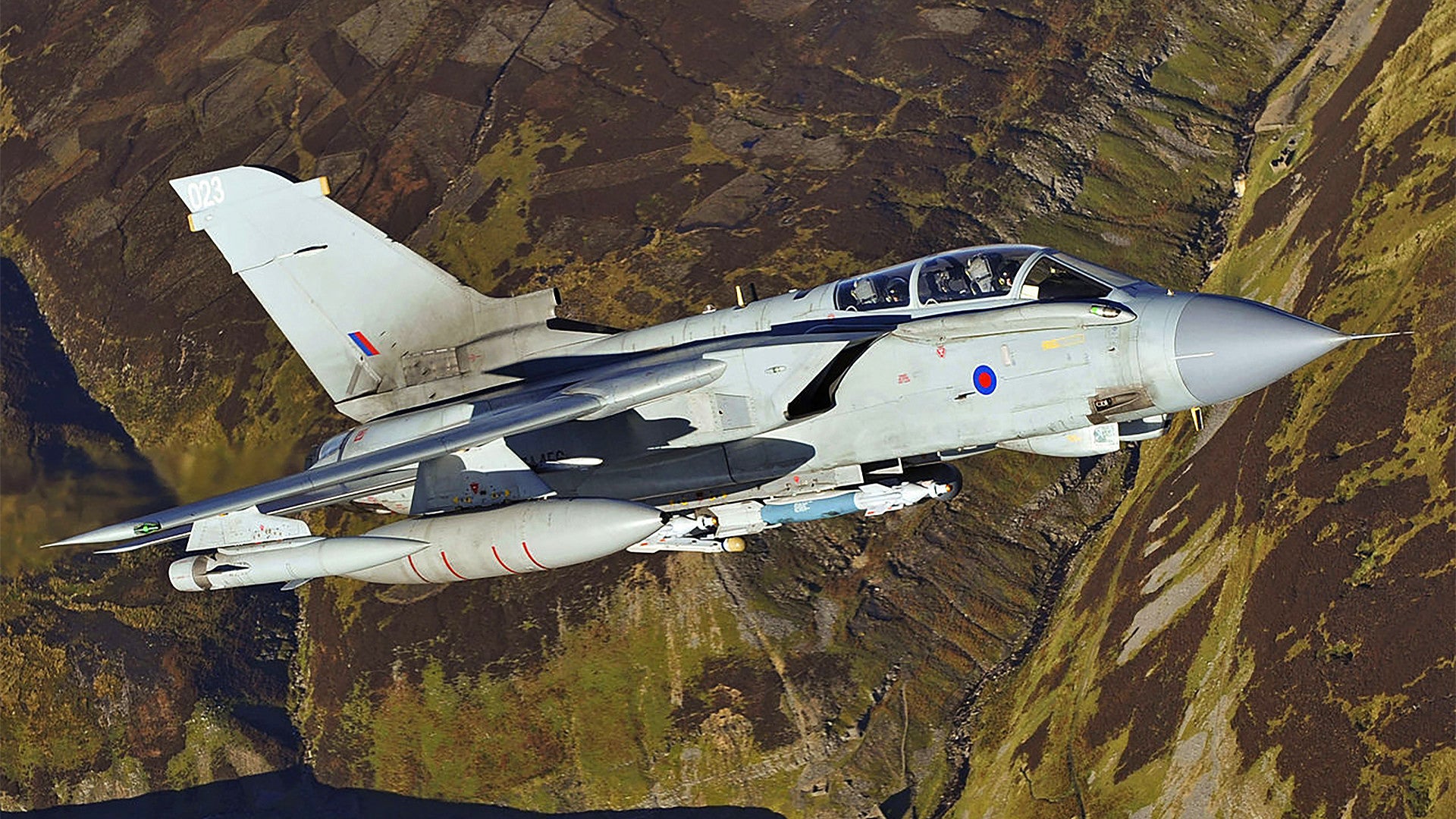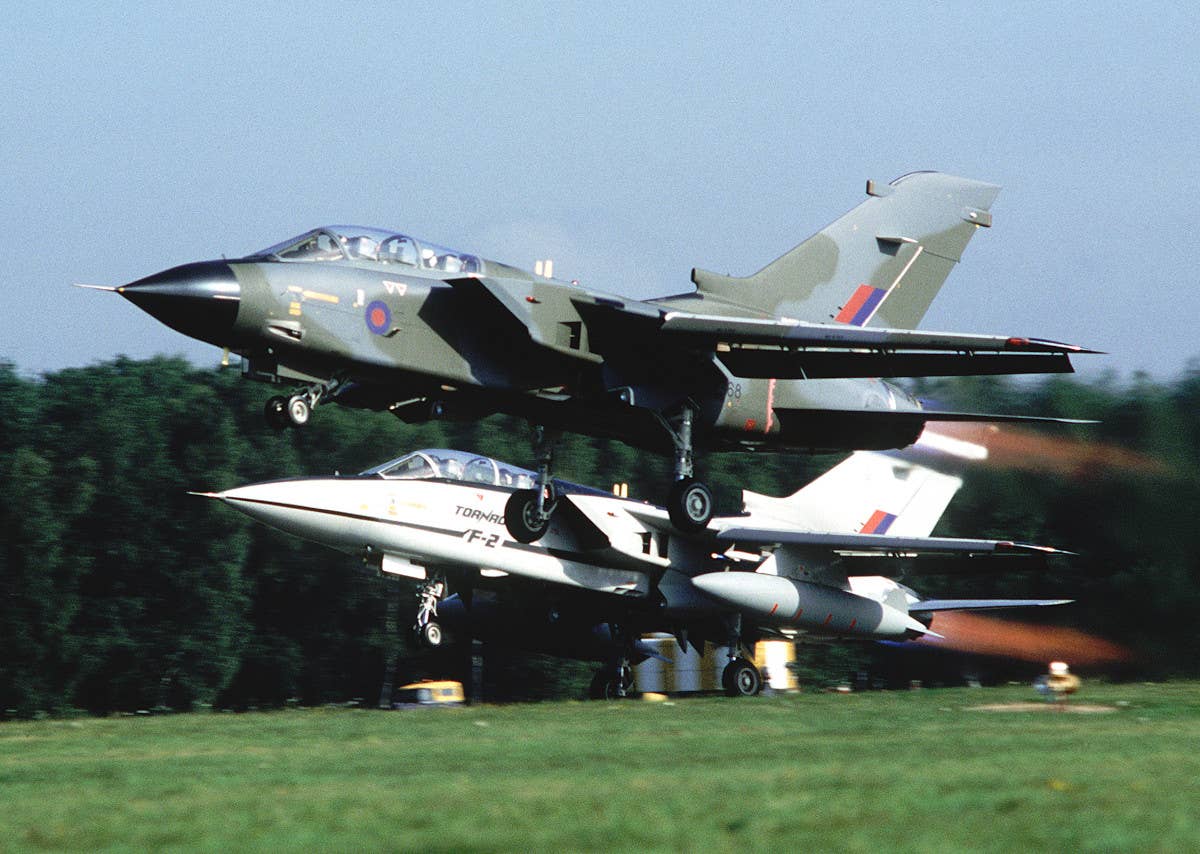Tornado Fighter Jets - The Panavia Tornado is a family of twin-engine, variable-wing multirole combat aircraft designed and manufactured jointly by Italy, the United Kingdom and West Germany. There are three main Tornado variants: the Tornado IDS (interdictor/attack) fighter-bomber, the Tornado ECR (electronic combat/reconnaissance) enemy air defense suppression, and the Tornado ADV interceptor (air defense variant).
The Tornado was designed and built by Panavia Aircraft GmbH, a tripartite consortium consisting of British Aerospace (formerly British Aircraft Corporation), MBB of West Germany and Aeritalia of Italy. It flew for the first time in 1974. on August 14, and was put into operation in 1979-1980. Due to its multi-role design, it was able to replace several different aircraft fleets in host air forces. The Royal Saudi Air Force (RSAF) became the sole export operator of the Tornado, apart from the three original partner countries. A tri-national training and evaluation unit operating from RAF Cottesmore, the Tornado Tri-National Training Establishment, maintained a level of international cooperation beyond the production phase.
Tornado Fighter Jets

The Tornado was operated by the Royal Air Force (RAF), the Italian Air Force and the RSAF during the 1991 Gulf War, during which the Tornado flew many low-altitude attack missions. Multi-service Tornadoes were also used in the Bosnian War, the Kosovo War, the Iraq War and the Libyan Civil War in 2011, as well as minor roles in Afghanistan, Yemen and Syria. 990 including all options
Panavia Tornado Gr1 > National Museum Of The United States Air Force™ > Display
In the 1960s, aeronautical designers sought variable geometry wing designs to gain the maneuverability and effective spread speed of straight wings. The UK canceled the purchase of the TSR-2 and later F-111K aircraft and was still looking for a replacement for its Avro Vulcan and Blackburn Buccaneer attack aircraft.
Britain and France started the BAC/Dassault AFVG (Anglo Frch Variable Geometry) project in 1965, but this ended with the French withdrawal in 1967.
Britain continued to develop a variable geometry aircraft similar to the proposed AFVG and sought new partners.
West German EWR with Boeing th with Fairchild-Hiller and Republic Aviation developed design studies for the EWR-Fairchild-Hiller A400 AVS Advanced Vertical Strike (which has a similar configuration to the Tornado) between 1964 and 1968.
Tornado Jets Are To Be Axed From The Raf
In 1968 West Germany, the Netherlands, Belgium, Italy and Canada formed a task force to study replacements for the Lockheed F-104 Starfighter.
Since the needs of the partner countries were so diverse, it was decided to create a single aircraft that could perform a variety of tasks previously carried out by a fleet of different aircraft.
Great Britain joined the MRCA group in 1968, represented by Air Vice-Marshal Michael Giddings, and in 1969 May. a memorandum of understanding was concluded between Great Britain, West Germany and Italy.

The project was politically unpalatable to Canada; it was believed in political circles that much of the production and specification was centered in Western Europe. France made a favorable offer to Belgium for the Dassault Mirage 5.
Raf Tornado Gr 4 Bomber Jet Aircraft Editorial Stock Photo
In 1969 March 26 four partner countries, the United Kingdom, Germany, Italy and the Netherlands, agreed to establish an international company, Panavia Aircraft GmbH, to develop and manufacture the MRCA.
The goal of the project was to create an aircraft capable of performing tactical attack, reconnaissance, air and maritime defense tasks.
The Netherlands withdrew from the project in 1970 claiming that the aircraft was too complex and technical for the RNLAF's wishes.
A further blow was delivered when Germany's demand in 1972 dropped from 600 aircraft to 324.
Germany's Tornado Fighter Replacement Plans Revealed
Germany is said to have deliberately made an unrealistic initial order to secure the company's headquarters and initial test flight in Germany rather than the UK in order to have more influence on the design.
When the deal was concluded, the United Kingdom and West Germany each had 42.5% of the workload, with Italy the remaining 15%; this distribution of production labor was greatly influenced by international political negotiations.
The fuselage and front tail assembly was assigned to BAC (now BAE Systems) in the UK; ctre fuselage to MBB (now part of Airbus) in West Germany; and wings for Aeritalia (now Leonardo) in Italy.

Similarly, a tripartite division of labor was used for gins and teams. in 1970 in June a separate international company, Turbo-Union, was created to develop and manufacture the RB199 aircraft, 40% Rolls-Royce, 40% MTU and 20% FIAT.
Germany's Air Force Fleet Unfit For Deployment
After the end of the definition phase of the project in 1970. in May, the concepts were reduced to two projects; the single-seat Panavia 100, initially preferred by West Germany, and the two-seat Panavia 200, preferred by the RAF.
In 1971 In September, the three governments signed an Intention to Proceed (ITP), at which time the aircraft was intended only for the low-level attack mission, where it was considered a viable threat to Soviet defenses.
It was at that time that the British Chief of Defense Staff announced that "two-thirds of the front line of the battle will be made up of this single type of aircraft."
The first of five aircraft built (nine prototypes P01 to P09 and six pre-production PS11 to PS 16) flew in 1974. 14 August Manching, Germany; pilot Paul Millet described his experience: "The handling of the aircraft was incredible...the actual flight was so smooth that I began to wonder if it was another simulation."
Buy Piececool Tornado Fighter 3d Metal Puzzle In Australia
Flight tests led to the need for minor changes. Airflow disruptions were responded to by re-profiling the engine intakes and fuselage to reduce lift and buffeting at supersonic speeds.
According to Jim Quinn, Tornado development simulation software programmer and expert on Tornado and Gine controls, the prototype was able to safely reach supercruise, but the engines had serious safety issues at high altitude when trying to slow down. At high altitude and low turbine speed, the supercharger did not provide enough pressure to maintain combustion pressure, causing vibration as combustion pressure would flow back into the intake port. To avoid this effect, the engine controls would automatically increase the minimum idle setting as altitude exceeded altitude, until at very high altitudes the idle setting was so high that it approached maximum dry thrust. As a result, one of the test aircraft got stuck at Mach 1.2 supercruise at high altitude and had to slow down by spinning the aircraft because the idle setting at that altitude was so high that the aircraft could not slow down.
The British Ministry of Supply appointed Chief Engineer Ted Talbot from the Concorde development team to provide design support to the Tornado development team to resolve these issues. soviet union German engineers working on the Tornado socket were unable to create a functional Concorde-style socket, despite having data from the Concorde team. To make matters worse, his management team mistakenly slammed the Concorde design and tried to sue the British specialists for providing them with the design. German lawyers learned that the British had submitted designs to the German team and asked for additional information to help their engineers overcome the Tornado's intake problems, but Chief Engineer Talbot refused. According to Talbot, Concorde's specialists determined that the problem with the Tornado's intake was that the gen did not respond to unexpected changes in intake position, causing the gen to fail to position the intake ramps. This was because the Concorde had a similar problem with the control pressure not being high enough to maintain proper intake ramp angles. Aerodynamic forces can force the jacks into the wrong position, so they should be able to control the genies if that happens. The Tornado intake system prevented this. Due to the behavior of the German management team, British engineers refused to share this information, so the Tornado was not fitted with the more advanced Concorde intake design.

Tests revealed that a front wheel rudder augmentation system was required along with a yaw damper to counteract the destabilizing effects of deactivating the thrust reverser during landing.
The Aircraft, Bombs And Missiles The Uk Could Use Against Isis In Syria
From 1967 to 1984 Soviet KGB officials were briefed on the tornado by the head of the West German Messerschmitt-Bölkow-Blohm planning department, Manfred Rotsch.
Two prototypes were lost in accidents, mainly due to bad piloting decisions and errors, which caused two ground collisions;
During the development of the type, aircraft designers of the time began to use features such as more sophisticated stability-enhancing systems and autopilots. Aircraft such as the Tornado and the General Dynamics F-16 Fighting Falcon used these new technologies.
Failure tests of the Tornado's Analog Control and Stability Augmentation System (CSAS) were conducted using a series of realistic flight controls; variable sweep wings combined with varied and often very heavy payloads made the removal process difficult.
File:raf Tornado Gr4 Aircraft Mod 45153868.jpg
The first planes were delivered
Northrop grumman fighter jets, us navy fighter jets, diecast fighter jets, fighter jets, fighter jets toys, fighter jets for sale, navy fighter jets, air force fighter jets, us military fighter jets, 6th generation fighter jets, lockheed martin fighter jets, metal toy fighter jets
0 Comments